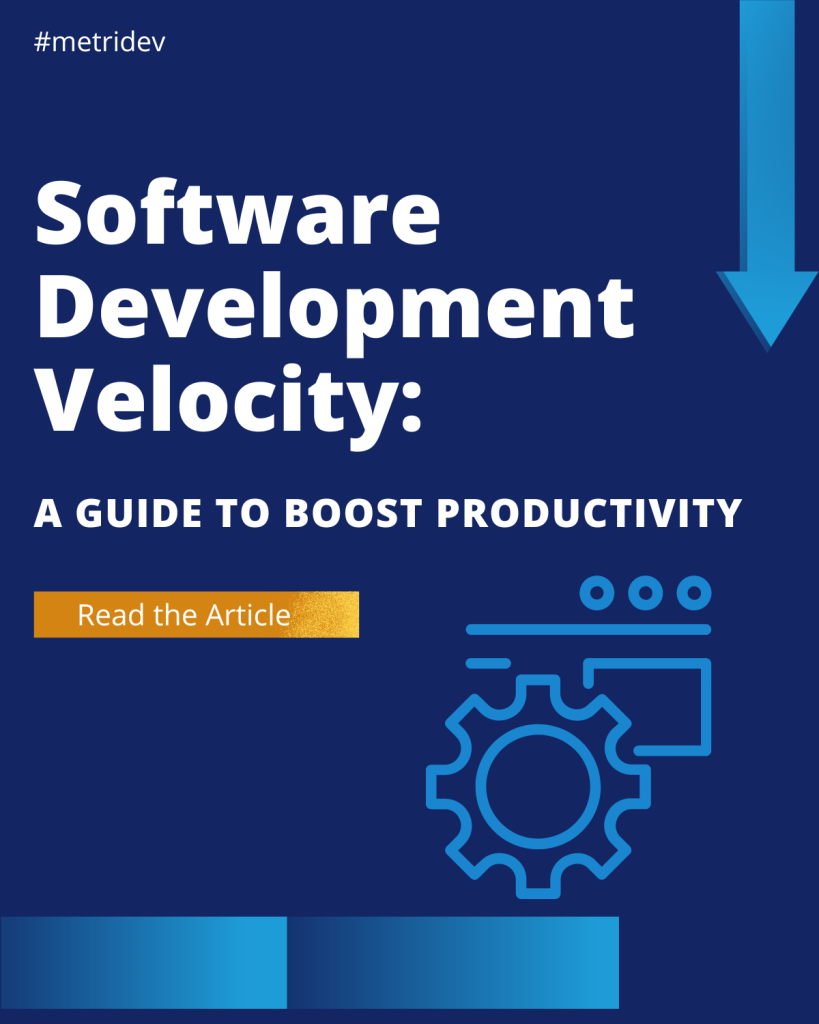Introduction
In today’s digital age, businesses are constantly seeking innovative ways to gain a competitive edge and drive success. Data driven development has emerged as a strategic approach that leverages the power of data to inform decision- making and optimize product development processes. By utilizing insights derived from data analysis, companies can make informed decisions, enhance their products, and deliver exceptional user experiences. This article explores the concept of data driven development, its benefits, key principles, implementation steps, tools and technologies, challenges, and best practices.
What is Data Driven Development?
Data driven development is an approach that emphasizes the use of data to drive decision-making throughout the product development lifecycle. It involves the collection, analysis, and interpretation of relevant data to inform the design, development, and improvement of digital products. By relying on data rather than intuition or assumptions, businesses can make more informed choices that align with user preferences, market trends, and organizational goals.
Benefits of a Data Driven Approach
Adopting a data driven approach offers numerous benefits to businesses. Firstly, it enables organizations to make evidence-based decisions. By relying on data rather than subjective opinions, businesses can reduce the risk of making costly mistakes and increase the likelihood of success. Additionally, a data driven approach allows for continuous improvement. By analyzing data, businesses can identify areas for optimization, iterate on product features, and enhance the overall user experience. This iterative process leads to greater customer satisfaction and loyalty.
Furthermore, data driven development enables businesses to gain a deeper understanding of their target audience. By analyzing user behavior and preferences, businesses can tailor their products to meet specific customer needs and preferences. This personalized approach enhances user engagement and fosters long-term relationships. Lastly, a data driven approach promotes innovation. By leveraging data insights, businesses can identify emerging trends, uncover new opportunities, and develop breakthrough products that disrupt the market.
A Data-Driven Approach to Developing Digital Products
Data driven development is particularly applicable in the context of digital product development. Whether it’s a mobile application, a website, or a software solution, a data driven approach can provide invaluable insights throughout the development process. It starts with gathering data related to user demographics, behavior, and preferences. This data can be collected through various sources such as surveys, user analytics, and customer feedback.
Once the data is collected, it is analyzed to identify patterns, trends, and user pain points. This analysis serves as the foundation for making informed decisions regarding product features, design elements, and user experience enhancements. The data also guides the testing and validation process, allowing businesses to fine-tune their products based on real user feedback.
Key Principles of Data Driven Development
To effectively implement a data driven approach, businesses should adhere to key principles. Firstly, it is important to define clear objectives and key performance indicators (KPIs) that align with organizational goals. This ensures that data collection and analysis efforts are focused and purposeful. Secondly, businesses should adopt a holistic approach to data collection, considering both quantitative and qualitative data sources. This provides a comprehensive understanding of user behavior and preferences.
Thirdly, data should be collected consistently and continuously throughout the development process. This enables businesses to track progress, measure the impact of changes, and identify areas for improvement. Fourthly, businesses should analyze data using statistical methods and data visualization techniques to derive meaningful insights. Lastly, businesses should cultivate a culture of data-driven decision-making, where they use insights to guide discussions and inform strategic choices.

Steps to Implement a Data Driven Approach
Implementing a data-driven approach requires careful planning and execution. Consequently, the following steps can serve as a roadmap for businesses looking to adopt this strategic approach:
- Firstly, define Objectives and KPIs: Clearly define the objectives of the product development process and identify key performance indicators that align with these objectives.
- Secondly, Collect Relevant Data: Determine the data sources that will provide valuable insights and collect data consistently throughout the development lifecycle.
- Thirdly, Analyze Data: Utilize statistical methods and data visualization techniques to analyze the collected data and identify patterns, trends, and user preferences.
- Next, Make Informed Decisions: Use the insights derived from data analysis to inform decision-making processes, such as feature prioritization, design choices, and user experience enhancements.
- Subsequently, Iterate and Improve: Continuously iterate on the product based on user feedback, data analysis, and market trends to enhance its performance and user satisfaction.
- Finally, Monitor and Measure: Regularly monitor and measure the impact of changes made based on data-driven decisions to assess the success of the product and identify areas for further improvement.
What are 3 Benefits of Data Driven Decision Making?
Data driven decision making offers several benefits to businesses:
1. Reduced Risk: By basing decisions on data rather than assumptions or intuition, businesses can reduce the risk of making costly mistakes and improve the chances of success.
2. Increased Efficiency: Data driven decision making allows businesses to optimize their processes, identify bottlenecks, and allocate resources effectively. This leads to improved efficiency and productivity.
3. Enhanced Customer Satisfaction: By understanding customer preferences and behavior through data analysis, businesses can deliver personalized experiences that meet customer needs, leading to higher satisfaction and loyalty.
Tools and Technologies for Data Driven Development
Implementing a data-driven approach necessitates leveraging various tools and technologies. These encompass Data Analytics Platforms, such as Google Analytics. These plataforms empower businesses to gather, analyze, and visualize data pertaining to user behavior, demographics, and preferences. Additionally, Data Visualization Tools. These tools play a crucial role in transforming raw data into comprehensible visualizations, facilitating easier interpretation and communication of insights. Moreover, Machine Learning and Artificial Intelligence technologies. They prove invaluable in uncovering intricate patterns and trends within vast datasets, thereby enabling businesses to garner deeper insights and formulate more precise predictions. Furthermore, robust Data Management Systems like Apache Hadoop. They furnish the requisite infrastructure for storing, processing, and managing large volumes of data efficiently.
What is Data-Driven in SDLC?
Data driven development can be integrated into every stage of the Software Development Life Cycle (SDLC) to enhance the effectiveness of the development process. In the requirements gathering phase, data analysis can help identify user needs and preferences. During the design phase, data can inform decisions regarding user interface elements and visual design choices. In the development phase, data can guide feature prioritization and testing efforts. Finally, in the post-release phase, data analysis can uncover areas for improvement and inform future iterations.
Challenges and Considerations
While data driven development offers significant benefits, there are challenges and considerations that businesses should be aware of. Firstly, there may be a lack of data literacy within the organization, requiring investment in training and education. Secondly, data quality and reliability can be a challenge, as it may be incomplete, inaccurate, or biased. Thirdly, privacy and data protection regulations must be adhered to when collecting and analyzing user data.
Additionally, businesses must ensure that the insights derived from data analysis are effectively communicated and understood by relevant stakeholders. Finally, implementing a data driven approach requires a cultural shift within the organization, as it may challenge traditional decision-making processes and require a willingness to embrace change.
Best Practices for Data Collection and Analysis
To maximize the effectiveness of data driven development, businesses should follow best practices for data collection and analysis. These include:
- Define Clear Objectives. Clearly define the objectives of data collection efforts and ensure they align with the overall goals of the organization.
- Collect Relevant and Reliable Data. Identify the data sources that will provide meaningful insights and ensure the data collected is accurate, complete, and representative of the target audience.
- Ensure Data Privacy and Security. Implement robust data privacy and security measures to protect user information and comply with relevant regulations.
- Utilize Statistical Analysis Techniques. Apply statistical analysis techniques to identify patterns, trends, and correlations in the data, enabling actionable insights to be derived.
- Visualize Data Effectively. Use data visualization techniques to communicate insights in a clear and compelling manner, making it easier for stakeholders to understand and act upon the findings.
- Continuously Monitor and Refine. Regularly review and refine data collection and analysis processes to ensure they remain relevant and aligned with evolving business needs and goals.
What is an Example of Data-Driven Programming?
Data-driven programming refers to the practice of using data to determine program behavior and logic. An example of data-driven programming is a recommendation system that analyzes user preferences, past behavior, and demographic data to provide personalized recommendations. The system uses data to dynamically adjust its algorithms and deliver relevant content to each user, enhancing the user experience and increasing engagement.
Measuring Success in Data Driven Development
To measure the success of data driven development initiatives, businesses can track key performance indicators (KPIs) that align with their objectives. These may include metrics such as user engagement, conversion rates, customer satisfaction scores, and revenue generated. By regularly monitoring these KPIs, businesses can assess the impact of data driven decisions and make adjustments as needed to drive further success.
What is the Difference Between Data Driven Framework and TDD Framework?
While both data driven development and Test-Driven Development (TDD) frameworks emphasize the use of data, they have distinct focuses. Data driven development primarily uses data to inform decision-making throughout the product development lifecycle. It leverages insights from data analysis to optimize product features, design choices, and user experiences.
On the other hand, TDD is a software development approach that emphasizes writing automated tests before writing code. It uses test cases and data scenarios to guide the development process, ensuring that the code meets the specified requirements. While TDD also relies on data, its primary focus is on testing and code quality rather than broader decision-making based on data analysis.
Conclusion
Data driven development has emerged as a strategic approach that empowers businesses to make informed decisions. Also to optimize product development processes, and deliver exceptional user experiences. By leveraging the power of data, businesses can reduce risk, increase efficiency, and enhance customer satisfaction. As technology continues to advance and data becomes increasingly abundant, the future of data driven development holds tremendous potential for businesses across industries. By embracing this approach and leveraging the right tools and techniques, businesses can position themselves for long-term success in the digital age.









Leave a Reply